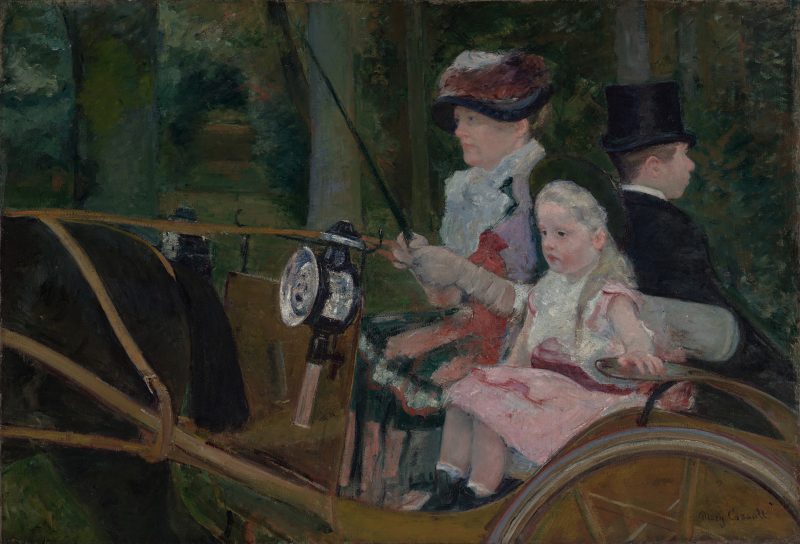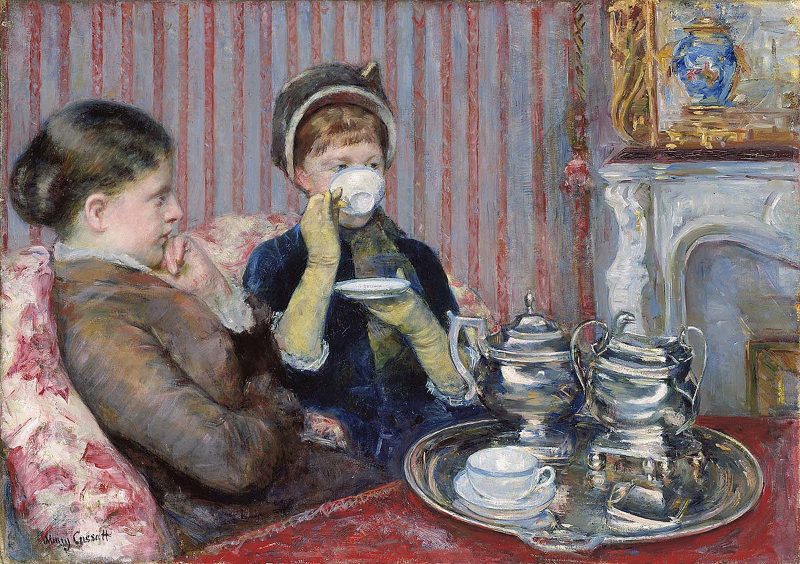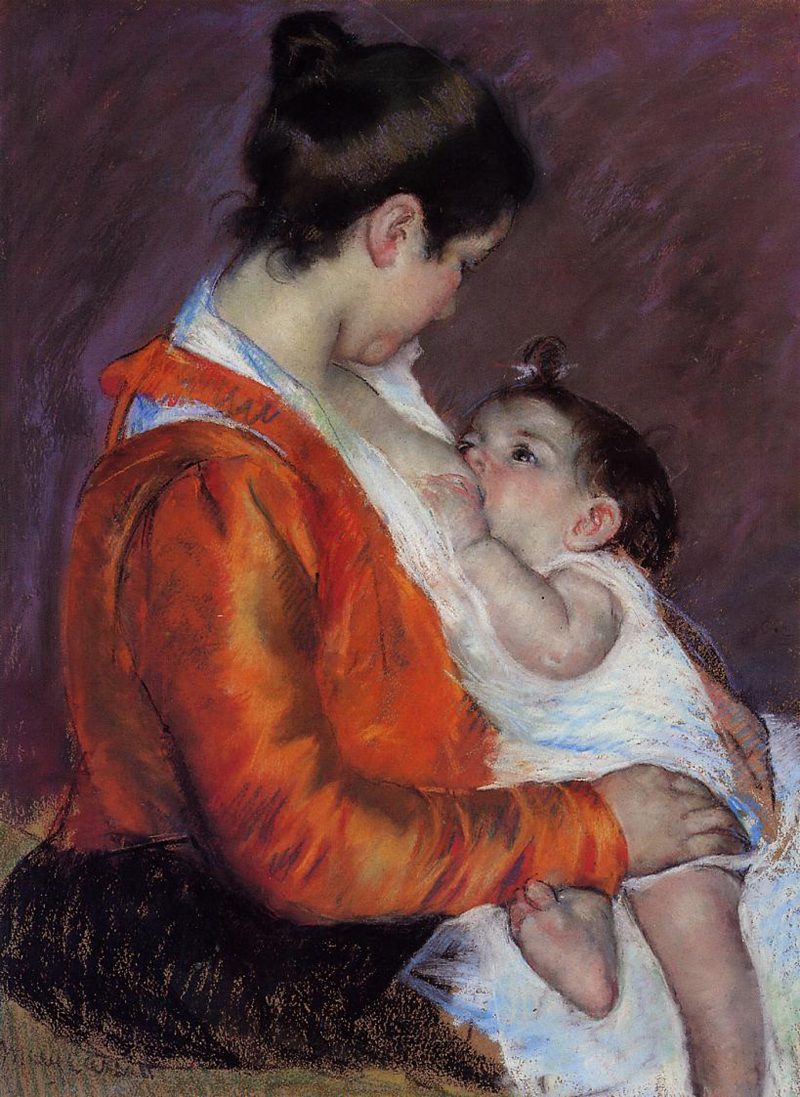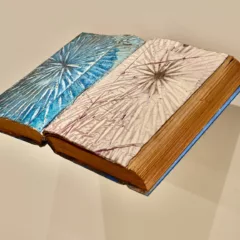
Writing in 1892, the Duchess of Fitz-James recorded that by the 1880s, Parisian women could be seen not only driving horse-drawn carriages in the countryside, as had been long practiced, but that they were doing so even in the city! As can be seen in “A Woman and a Girl Driving” (1881), an oil painting by American-born painter Mary Cassatt, women were beginning to take the reins, but in more than one way. The painting, which is currently on view at the Philadelphia Museum of Art in the exhibition, “The Impressionist’s Eye,” reminds viewers of a pivotal historical moment during which people across the Western world witnessed the emergence of the “New Woman,” an educated and independent woman who might be considered a pre-cursor to first-wave feminists. Cassatt herself would have been considered this new type.
Although perhaps less celebrated than her fellow male impressionists, Cassatt’s career has long been the subject of academic interest. Born near Pittsburgh, Pennsylvania in 1844, she moved with her family to Philadelphia at the age of six where she began her formal schooling. Born to a well-to-do family, Cassatt had more options than working class women and was able to pursue her interests at length. At fifteen, the budding artist began studying at the Pennsylvania Academy of Fine Arts – an uncommon educational choice for women at the time. The Academy was renowned as one of the best art institutions in America, producing several other celebrated artists such as her classmate Thomas Eakins, another Philadelphian artist who went on to be greatly esteemed in the art world.
Alongside the benefits of receiving an excellent formal education, her artistic training was supplemented by international travel. On her trips abroad, she was exposed to the art of French artists such as Eugène Delacroix, Gustave Courbet, and, most importantly, Edgar Degas – an avant garde artist who later became her mentor and friend. By the 1870s, Cassatt began to achieve success and recognition after several works were exhibited at the famed Parisian salons. In 1879, she was invited to exhibit with the Impressionists, the Parisian avant-garde, after her work became too modern and radical for the more traditional French Academy. Preferring to portray scenes of modern life, Cassatt defied the old guard who favored large-scale paintings of historical and mythological scenes.

When encountering Cassatt’s oeuvre, it is important to keep in mind that her work must be read differently than those by male modernist artists. Cassatt often called upon her lived experiences as a woman to portray the feminine psychological experiences of her time, and her gender often allowed her entry to all-female occasions – a privilege frequently denied to her male colleagues. In “The Tea” (1880), currently owned by the Museum of Fine Arts in Boston, Cassatt pictures two young women lounging in a luxurious salon as they sip their tea. One woman still dons her gloves and hat, hinting that she has just stepped in from the bustling boulevards of Paris to take her tea with the other ladies. On the carved marble fireplace is a decorative vase and a painting contained by a gilded frame. The wallpaper and cushions are also decorated with an ornate pattern. Such details lend to a luxurious setting in which Cassatt reveals a passing moment in the lives of her contemporaries, other women of high social standing.
It is not the luxurious setting that draws the eye, however, but rather the women occupying the space. Both women gaze across the table and tea set. Although there are only two tea cups visible, it is easy to imagine that the pair are a part of a much larger group of women that have gathered with other ladies to discuss the events of their lives in the city. One can at least assume that Cassatt herself takes part in the tea. The woman on the left especially gives pause. Likely among trusted peers, she sits in an informal position, the stiff bodice of her dress denying full relaxation, and with her hand propping her chin delicately as she listens pensively. Her other arm is folded across her midsection and her empty cup sits on the table before her. Amidst the grandeur of the room, this woman is still able to hold our gaze. She is not posed. The moment is candid. Unguarded in appearance, the meditative woman provides a psychological dimension to the piece.

Not only did Cassatt have access to the intimate, private moments of women, her lived experience as a woman herself fitted her with a different lens. “A Woman Nursing a Child” (1894), in storage at the National Galleries Scotland, by Pierre-Auguste Renoir depicts a woman gazing lovingly at her offspring, who lays across her knee, latched to her partially exposed breast. Although Renoir’s scene reveals his close attention to detail, a similar picture by Cassatt illustrates her unique viewpoint. In “Louise Nursing Her Child” (1898), a painting owned by the Fondation Rau in Zurich, Cassatt enters the scene from an alternative perspective, emphasizing not the mother’s face as does Renoir, but instead the child’s. This change in perspective has dramatic effect. The viewer can now see the child’s contented expression and the baby’s grubby hand resting delicately on mother’s breast, details that greatly deepen the sentiment of affection and familiarity expressed in the work.

Keeping Cassatt’s female perspective in mind, we can now return to “A Woman and a Girl Driving.” Thought to be a portrait of her sister Lydia, the work is more than just a pretty picture – it is a feminist declaration. Once more, we see Cassatt’s ability to capture a psychological dimension on display. Lydia’s livery is befitting a woman of her high status as is the young girl’s, and the pair make a lovely sight garnished with feather and bow. However, it is not the beautiful clothing that draws the eye. Much like in “The Tea,” it is Lydia’s gaze that begs further consideration. Brows slightly knitted in concentration, Lydia focuses on the matter at hand. It is not her attire that is noteworthy, but her self-reliant and confident expression.
Cassatt strategically places Lydia’s hands, which command the reins, in the center of the piece, drawing the eye immediately. She handles the reins effortlessly, guiding the carriage with ease. The riding crop is at the ready if needed. The top-hatted valet is seated in the back of the carriage and is given few physical details, allowing the figure to fade from focus. Most remarkable is Cassatt’s choice to place the girl’s head just next to Lydia’s hands. This young girl, Cassatt reminds us, will grow up with the “New Woman” type close at hand. With the benefit of hindsight, we know that women like Mary and Lydia Cassatt helped encourage the next generation of women to take the reins as well.
The Impressionist’s Eye, through Aug. 18, 2019. Philadelphia Museum of Art, Main Building. 26th and Ben Franklin Parkway.









